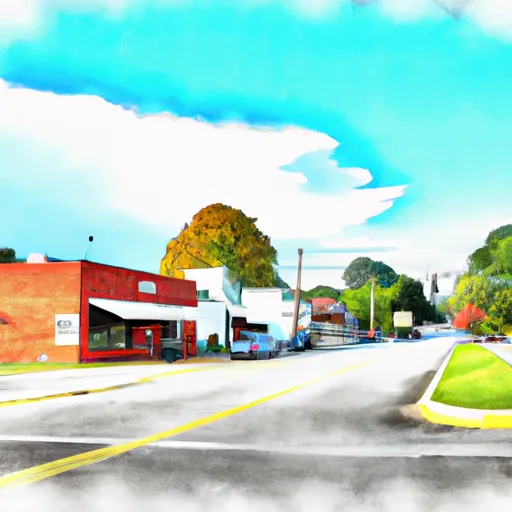-
 Snoflo Premium
Snoflo Premium
Get unlimited access to all our content
With no Ad interruptions! - Start Your Free Trial Login with existing account
Minor-Hill
Eden Index
Climate
7.5
•
Recreation
0.6
•
Community
0.7
•
Safeguard
3.4/10

Minor Hill is a charming town located in Giles County, Tennessee. It experiences a humid subtropical climate, characterized by hot summers and mild winters. Summers in Minor Hill are usually hot and humid, with average temperatures ranging from the mid-80s to low 90s Fahrenheit. Winters are mild, with average temperatures in the mid-40s to mid-50s.
The town is surrounded by beautiful natural landscapes and is blessed with an abundance of water resources. The hydrology of Minor Hill includes several creeks and streams, such as Whittle Hollow Creek and Cox Hollow Creek, which provide opportunities for fishing, kayaking, and other water-based activities. The nearby Buffalo River and its tributaries offer additional outdoor recreation options.
For outdoor enthusiasts, Minor Hill has numerous opportunities for hiking, camping, and exploring nature. The town is close to the picturesque Natchez Trace Parkway, a historic road that offers scenic drives and hiking trails. Nearby natural areas, such as David Crockett State Park and the natural beauty of the Tennessee River, provide opportunities for camping, boating, and wildlife watching.
Overall, Minor Hill's pleasant climate, abundant water resources, and surrounding natural beauty make it an ideal destination for outdoor recreation enthusiasts.
What is the Eden Index?
The Snoflo Eden Index serves as a comprehensive rating system for regions, evaluating their desirability through a holistic assessment of climate health, outdoor recreation opportunities, and natural disaster risk, acknowledging the profound impact of these factors on livability and well-being.
Climate Health Indicator (CHI): 7.5
Minor-Hill receives approximately
1441mm of rain per year,
with humidity levels near 88%
and air temperatures averaging around
15°C.
Minor-Hill has a plant hardyness factor of
7, meaning
plants and agriculture in this region tend to thrive during the non-winter months.
By considering the ideal temperature range, reliable water supplies, clean air, and stable seasonal rain or snowpacks, the Climate Health Indicator (CHI) underscores the significance of a healthy climate as the foundation for quality living.
A healthy climate is paramount for ensuring a high quality of life and livability in a region, fostering both physical well-being and environmental harmony. This can be characterized by ideal temperatures, reliable access to water supplies, clean air, and consistent seasonal rain or snowpacks.
Weather Forecast
Streamflow Conditions
Middle Tennessee-Elk
Area Rivers
Middle Tennessee-Elk
Snowpack Depths
Middle Tennessee-Elk
Reservoir Storage Capacity
Middle Tennessee-Elk
Groundwater Levels
Recreational Opportunity Index (ROI): 0.6
The Recreational Opportunity Index (ROI) recognizes the value of outdoor recreational options, such as parks, hiking trails, camping sites, and fishing spots, while acknowledging that climate plays a pivotal role in ensuring the comfort and consistency of these experiences.
Access to outdoor recreational opportunities, encompassing activities such as parks, hiking, camping, and fishing, is crucial for overall well-being, and the climate plays a pivotal role in enabling and enhancing these experiences, ensuring that individuals can engage in nature-based activities comfortably and consistently.
Camping Areas
| Campground | Campsites | Reservations | Toilets | Showers | Elevation |
|---|---|---|---|---|---|
| Six Mile Creek | None | 110 ft | |||
| Tannehill Ironworks Historical State Park | 300 | 435 ft | |||
| Elm Bluff - William Dannelly Reservoir | None | 103 ft | |||
| Blue Creek | None | 195 ft | |||
| Lake Stone | None | 111 ft | |||
| Paul M Grist State Park | 11 | 337 ft | |||
| Burchfield Branch Park | 36 | 473 ft | |||
| Chilatchee Creek | 33 | 107 ft | |||
| Roland Cooper State Park | 60 | 85 ft | |||
| Clear Creek RV Military - Fort Knox | 10 | 141 ft |
Nearby Ski Areas
Catastrophe Safeguard Index (CSI):
The Catastrophe Safeguard Index (CSI) recognizes that natural disaster risk, encompassing floods, fires, hurricanes, and tornadoes, can drastically affect safety and the overall appeal of an area.
The level of natural disaster risk in a region significantly affects safety and the overall livability, with climate change amplifying these risks by potentially increasing the frequency and intensity of events like floods, fires, hurricanes, and tornadoes, thereby posing substantial challenges to community resilience and well-being.
Community Resilience Indicator (CRI): 0.7
The Community Resilience Indicator (CRI) recognizes that education, healthcare, and socioeconomics are crucial to the well-being of a region. The CRI acknowledges the profound impact of these elements on residents' overall quality of life. By evaluating educational resources, healthcare accessibility, and economic inclusivity, the index captures the essential aspects that contribute to a thriving community, fostering resident satisfaction, equity, and social cohesion.

